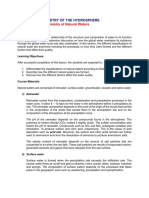Interpersonal Communication
Interpersonal Communication
Uploaded by
cory kurdapyaCopyright:
Available Formats
Interpersonal Communication
Interpersonal Communication
Uploaded by
cory kurdapyaOriginal Title
Copyright
Available Formats
Share this document
Did you find this document useful?
Is this content inappropriate?
Copyright:
Available Formats
Interpersonal Communication
Interpersonal Communication
Uploaded by
cory kurdapyaCopyright:
Available Formats
Interpersonal Communication
Introduction
It’s difficult to imagine for any organization which doesn’t require one people to interact
with other people. Employees of the organization likely use interpersonal communication every
day to handle complaints from their customers, to persuade their superiors to give you some
time off, or to comfort a colleague dealing with difficult problems. Interpersonal communication
in recent years has been consistently placed high as an important requirement for conducting
successful job performance in the organizations. This is why companies and institutions put a
high importance on interpersonal communication.
Discussion
A. Interpersonal Communication
Interpersonal Communication is the process of transmitting information and common
understanding from one person to another, which is very essential for the success of any
organization. Therefore, it must be effectively handled to ensure the attainment of the
organization’s goals. Vardaman and Halterman define communication inside the organization as
the flow of information, materials, perceptions and understandings among the various
stakeholders of the organization, all the methods, media and means of the communication, all
the networks, channels, systems of communication or organizational structure, all the person –
to – person interchange or interpersonal communication. They include all aspects of
communication and make it comprehensive, because it advises that there are so plentiful things
are going on in the organization.
Communication in different organization is very vigorous and that is the reason
Greenbaum contends that the tenacity of organizational communication is to facilitate the
attainment of organizational objectives [9]. Interpersonal communication provides a way of
reaching others with facts, ideas, thoughts and values. It is a connection of meaning among
employees so that they can share what they know and feel.[6] Interpersonal communication is a
term usually applied to verbal and nonverbal interfaces in one-on-one or some small-group
settings. “People skills” and “soft skills” are terms often used to label someone’s interpersonal
competence, though the word “soft”
B. Barriers to Effective Organizational Communication
Some barriers of organizational communication have been identified as they affect the
effectiveness of organizational. These barriers include:
1. Lack of clarity: Failure to use common language and honest expressions.
2. Lack of proper coordination: Organizational Failure to coordinate the various
activities of the different departments in the organization frequently results in pitiable
interpersonal communication, repetition of effort and regular irritation and frustration for
the employees affected. Proper channel of interpersonal communication in organization
has to be followed for improving the organizational productivity.
3. Lack of adequate organizational equipment: Lack of necessary communication
facilities can significantly hamper the proper functioning of a business environment in the
organization. Interpersonal organizational communication remains effective when all the
required facilities are put in the organization and the employees are trained.
C. Major Challenges to Organizational Effectiveness
The challenge for businesses organizations seems simple: align and engage employee’s
workforce to a clearly expressed strategy. However, this can be a challenge to attain. It requires
a complete, coordinated effort to put a large number of building blocks or key elements in place.
The key elements of organizational effectiveness are needed to motivate employee
engagement in the organizations. Employee engagement influences the clients’ experience and,
ultimately, the complete performance of an organization in terms of efficiency and profitability.
E. Inter Personal Communication and Organizational Effectiveness
Interpersonal Communication can be an effective tool for motivating employees of the
organization involved in various activities. Appropriate communications provide employees with
feedback and reinforcement during the effective organizational change [14]. The effective
organizational change, for increasing organizational affectivity, enables employees to make
better decisions and prepares them for the advantages and disadvantages of change [15].
Employee involvement in various organizational activity increases employees input into
decisions which affects organizational performance.
Conclusion
Communication is the process of transmitting information and common understanding
from one person to another. Every organization, regardless of industry or country, seeks to be
more effective and achieve superior results. Business strategy is developed to achieve this.
Execution occurs when structure, roles, capability, leadership, systems, and culture are all
pulling together and aligned with the strategy. One without the other will create misalignment
and success will not be realized. The main consideration to this study is the capture of
respondents’ perceptions of effectiveness of interpersonal communication at a single point in
time. The organizations performance depends on leader’s interpersonal skill in change
implementation over the life of an organizational affectivity. This paper identify that key point
of interpersonal communication is assertion, thus the most critical tactics in effective
interpersonal communication are assertion strategies. The people strong in interpersonal
communication can stand up for their rights, disagree and present different points of view
without intimation or putting the other employees down for making the organization more
effective.
Reference:
researchgate.net/publication/293401752_Role_of_Interpersonal_Communication_in_Organizati
onal_Effectiveness
You might also like
- The Subtle Art of Not Giving a F*ck: A Counterintuitive Approach to Living a Good LifeFrom EverandThe Subtle Art of Not Giving a F*ck: A Counterintuitive Approach to Living a Good LifeRating: 4 out of 5 stars4/5 (5935)
- The Gifts of Imperfection: Let Go of Who You Think You're Supposed to Be and Embrace Who You AreFrom EverandThe Gifts of Imperfection: Let Go of Who You Think You're Supposed to Be and Embrace Who You AreRating: 4 out of 5 stars4/5 (1106)
- Never Split the Difference: Negotiating As If Your Life Depended On ItFrom EverandNever Split the Difference: Negotiating As If Your Life Depended On ItRating: 4.5 out of 5 stars4.5/5 (879)
- Grit: The Power of Passion and PerseveranceFrom EverandGrit: The Power of Passion and PerseveranceRating: 4 out of 5 stars4/5 (598)
- Hidden Figures: The American Dream and the Untold Story of the Black Women Mathematicians Who Helped Win the Space RaceFrom EverandHidden Figures: The American Dream and the Untold Story of the Black Women Mathematicians Who Helped Win the Space RaceRating: 4 out of 5 stars4/5 (925)
- Shoe Dog: A Memoir by the Creator of NikeFrom EverandShoe Dog: A Memoir by the Creator of NikeRating: 4.5 out of 5 stars4.5/5 (545)
- The Hard Thing About Hard Things: Building a Business When There Are No Easy AnswersFrom EverandThe Hard Thing About Hard Things: Building a Business When There Are No Easy AnswersRating: 4.5 out of 5 stars4.5/5 (353)
- Elon Musk: Tesla, SpaceX, and the Quest for a Fantastic FutureFrom EverandElon Musk: Tesla, SpaceX, and the Quest for a Fantastic FutureRating: 4.5 out of 5 stars4.5/5 (476)
- Her Body and Other Parties: StoriesFrom EverandHer Body and Other Parties: StoriesRating: 4 out of 5 stars4/5 (831)
- The Emperor of All Maladies: A Biography of CancerFrom EverandThe Emperor of All Maladies: A Biography of CancerRating: 4.5 out of 5 stars4.5/5 (274)
- The Little Book of Hygge: Danish Secrets to Happy LivingFrom EverandThe Little Book of Hygge: Danish Secrets to Happy LivingRating: 3.5 out of 5 stars3.5/5 (419)
- The World Is Flat 3.0: A Brief History of the Twenty-first CenturyFrom EverandThe World Is Flat 3.0: A Brief History of the Twenty-first CenturyRating: 3.5 out of 5 stars3.5/5 (2271)
- The Yellow House: A Memoir (2019 National Book Award Winner)From EverandThe Yellow House: A Memoir (2019 National Book Award Winner)Rating: 4 out of 5 stars4/5 (99)
- Devil in the Grove: Thurgood Marshall, the Groveland Boys, and the Dawn of a New AmericaFrom EverandDevil in the Grove: Thurgood Marshall, the Groveland Boys, and the Dawn of a New AmericaRating: 4.5 out of 5 stars4.5/5 (270)
- The Sympathizer: A Novel (Pulitzer Prize for Fiction)From EverandThe Sympathizer: A Novel (Pulitzer Prize for Fiction)Rating: 4.5 out of 5 stars4.5/5 (122)
- Team of Rivals: The Political Genius of Abraham LincolnFrom EverandTeam of Rivals: The Political Genius of Abraham LincolnRating: 4.5 out of 5 stars4.5/5 (235)
- A Heartbreaking Work Of Staggering Genius: A Memoir Based on a True StoryFrom EverandA Heartbreaking Work Of Staggering Genius: A Memoir Based on a True StoryRating: 3.5 out of 5 stars3.5/5 (232)
- On Fire: The (Burning) Case for a Green New DealFrom EverandOn Fire: The (Burning) Case for a Green New DealRating: 4 out of 5 stars4/5 (75)
- Gec 19 - Jose Rizal (Midterm)Document5 pagesGec 19 - Jose Rizal (Midterm)arcreyes100% (1)
- The Unwinding: An Inner History of the New AmericaFrom EverandThe Unwinding: An Inner History of the New AmericaRating: 4 out of 5 stars4/5 (45)
- Prime-Hrm Performance Management System Coaching Guide (Grow Model) About The ModelDocument4 pagesPrime-Hrm Performance Management System Coaching Guide (Grow Model) About The Modelcory kurdapyaNo ratings yet
- DOC-2022-137 Add-Corr To DM-170-2022 DivCap IPBTDocument2 pagesDOC-2022-137 Add-Corr To DM-170-2022 DivCap IPBTcory kurdapyaNo ratings yet
- Math6 ST3 Q1Document2 pagesMath6 ST3 Q1cory kurdapyaNo ratings yet
- DOC-2022-136 DA Date and Venue of IPBT DivCap (DA-93-2022)Document1 pageDOC-2022-136 DA Date and Venue of IPBT DivCap (DA-93-2022)cory kurdapyaNo ratings yet
- Chapter 6 - PolymersDocument123 pagesChapter 6 - Polymerscory kurdapyaNo ratings yet
- 9.2 The Chemistry of Natural WatersDocument3 pages9.2 The Chemistry of Natural Waterscory kurdapyaNo ratings yet
- LESSON 3: Air Pollution, Sources and Effects: Chapter 8: Chemistry of The AtmosphereDocument6 pagesLESSON 3: Air Pollution, Sources and Effects: Chapter 8: Chemistry of The Atmospherecory kurdapyaNo ratings yet
- 10.1 Properties of SoilDocument6 pages10.1 Properties of Soilcory kurdapyaNo ratings yet
- CHAPTER 8: The Chemistry of The AtmosphereDocument2 pagesCHAPTER 8: The Chemistry of The Atmospherecory kurdapyaNo ratings yet
- CHAPTER 5: Metals: Main Group Al, Ga, In, SN, TL, PB, Bi, PoDocument5 pagesCHAPTER 5: Metals: Main Group Al, Ga, In, SN, TL, PB, Bi, Pocory kurdapyaNo ratings yet
- 2.4 Basic Concepts of Crystal StructureDocument7 pages2.4 Basic Concepts of Crystal Structurecory kurdapyaNo ratings yet
- Objectives Code Percenta Ge No. of Items Item Placement: Guro Ako ChannelDocument3 pagesObjectives Code Percenta Ge No. of Items Item Placement: Guro Ako Channelcory kurdapyaNo ratings yet
- Mathematics 6 Summative Test - 2 Quarter I. Blacken The Letter of The Correct AnswerDocument2 pagesMathematics 6 Summative Test - 2 Quarter I. Blacken The Letter of The Correct Answercory kurdapyaNo ratings yet
- Lesson 2: Understanding The World of Thermodynamics: Module 1: Energy Chapter 1: FuelsDocument4 pagesLesson 2: Understanding The World of Thermodynamics: Module 1: Energy Chapter 1: Fuelscory kurdapyaNo ratings yet
- 2.4 Integrands Involving Quadratic ExpressionsDocument2 pages2.4 Integrands Involving Quadratic Expressionscory kurdapyaNo ratings yet
- 2.2 Trigonometric SubstitutionDocument2 pages2.2 Trigonometric Substitutioncory kurdapyaNo ratings yet
- Interpersonal Management Skills For Business SuccessDocument4 pagesInterpersonal Management Skills For Business Successcory kurdapyaNo ratings yet
- Sunnahof Tufers Description Voluntary ProjectDocument5 pagesSunnahof Tufers Description Voluntary ProjectMundusNo ratings yet
- 2.medical Ethics, Professionalism and Doctor-Patient RelationshipDocument19 pages2.medical Ethics, Professionalism and Doctor-Patient RelationshipFaisal Mehboob100% (1)
- Case Analysis 19bal037,19bal077,19bal084,19bal087Document7 pagesCase Analysis 19bal037,19bal077,19bal084,19bal087himanshu charanNo ratings yet
- Chen Wei A Paper Tiger Credit Hire NewsletterDocument8 pagesChen Wei A Paper Tiger Credit Hire NewsletterHogiwanNo ratings yet
- The Taxonomy of Project DefinitionsDocument3 pagesThe Taxonomy of Project DefinitionsFurr Amiruddin TikingNo ratings yet
- Data Analysis: 1. For How Many Years You Are Practicing As A Medical Practicener (Doctor) ?Document27 pagesData Analysis: 1. For How Many Years You Are Practicing As A Medical Practicener (Doctor) ?Abhinay nath DwivediNo ratings yet
- The Art of Tea Positions Description - Warehouse, Packing & DespatchDocument2 pagesThe Art of Tea Positions Description - Warehouse, Packing & DespatchdnmuleNo ratings yet
- BSP Circular 949Document6 pagesBSP Circular 949MARC CHRISTIAN LOPEZNo ratings yet
- Cross-Cultural Negotiation and Decision Making: Powerpoint by Kristopher Blanchard North Central UniversityDocument27 pagesCross-Cultural Negotiation and Decision Making: Powerpoint by Kristopher Blanchard North Central UniversityAnindita PaulNo ratings yet
- Jhoms PeDocument5 pagesJhoms PeMecaila FloraldeNo ratings yet
- 318D L Series 2: Hydraulic ExcavatorDocument32 pages318D L Series 2: Hydraulic ExcavatorFelipe Pisklevits LaubeNo ratings yet
- Historical Transformations in Boundary & Land Use in Rural' DelhiDocument1 pageHistorical Transformations in Boundary & Land Use in Rural' Delhisuhani100% (1)
- GCUF Teaching PDFDocument9 pagesGCUF Teaching PDFSulaim SarfrazNo ratings yet
- Police Organization and AdministrationDocument20 pagesPolice Organization and AdministrationKelvin100% (1)
- Business-Level StrategyDocument36 pagesBusiness-Level Strategyravisky1989No ratings yet
- Case Analysis ShampooDocument6 pagesCase Analysis ShampooMEDISHETTY MANICHANDANANo ratings yet
- Proposed Rule: Airworthiness Directives: Cubcrafters, Inc., Model PC18&ndash 160Document2 pagesProposed Rule: Airworthiness Directives: Cubcrafters, Inc., Model PC18&ndash 160Justia.comNo ratings yet
- On Snap ChatDocument19 pagesOn Snap ChatROHIT JAISWALNo ratings yet
- Poetry in P and IsDocument9 pagesPoetry in P and IsAbeer ANo ratings yet
- 01 Handout 1Document7 pages01 Handout 1Aina SheeneNo ratings yet
- Pengembangan Bahan Ajar Cetak Dalam Bentuk Komik Untuk Siswa Kelas Iii Sekolah DasarDocument8 pagesPengembangan Bahan Ajar Cetak Dalam Bentuk Komik Untuk Siswa Kelas Iii Sekolah DasarfadilahNo ratings yet
- FDI Opportunity and Challenges in NepalDocument16 pagesFDI Opportunity and Challenges in NepalsamsonNo ratings yet
- BBA 5th SemesterDocument1 pageBBA 5th SemesterNakul RathiNo ratings yet
- Bringing Asha Home Lesson PlanDocument3 pagesBringing Asha Home Lesson Planapi-316856662No ratings yet
- CAPE Communication Studies 2012 P1A PDFDocument11 pagesCAPE Communication Studies 2012 P1A PDFsashaNo ratings yet
- Jerin Jose - Internship ReviewDocument30 pagesJerin Jose - Internship Reviewഅന്തോണി നായർNo ratings yet
- Tactical Convoy Ops: Multi-Service Tactics, Techniques, and Procedures For Tactical Convoy OperationsDocument136 pagesTactical Convoy Ops: Multi-Service Tactics, Techniques, and Procedures For Tactical Convoy OperationsFippeFi100% (2)
- UP Diliman Return-to-Work Guidelines: Post-ECQ Guidelines For Administrative ProcessesDocument11 pagesUP Diliman Return-to-Work Guidelines: Post-ECQ Guidelines For Administrative ProcessesgurnaNo ratings yet
- Warrantless Arrests, Searches and Seizures and Privacy of CommunicationDocument374 pagesWarrantless Arrests, Searches and Seizures and Privacy of CommunicationPen MalubagNo ratings yet























































































